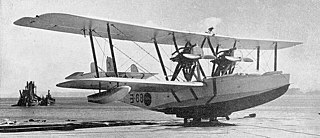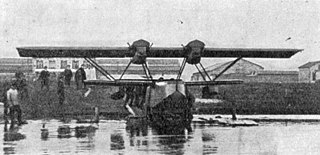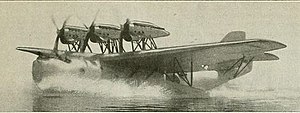
The Supermarine Scapa was a British general reconnaissance flying boat built by Supermarine that was used by the Royal Air Force between 1935 and 1939. It was developed from the Southampton and formed the basis of the Supermarine Stranraer.
The Naval Aircraft Factory TF was an American twin-engine flying-boat escort fighter first flown in October 1920. The aircraft originated from requirements drafted by the British Technical Committee in April 1918, after discussion approved the development of a long-range seaborne fighter capable of escorting Allied maritime reconnaissance sorties over the North Sea and Atlantic regions.
The Donnet-Denhaut flying boat was a maritime patrol and anti-submarine warfare aircraft produced in France during the First World War. Known at the time simply as "Donnet-Denhaut" or "DD" flying boats, the DD-2, DD-8, DD-9, and DD-10 designations were applied retrospectively to denote the various changes in configuration made during their service life.

The FBA Type A and the similar Type B and C were a family of reconnaissance flying boats produced in France prior to and during World War I.

The FBA Type H was a French reconnaissance flying boat produced in large numbers in France and Italy during World War I by Franco-British Aviation.

The Hiro H4H was a 1930s Japanese bomber or reconnaissance monoplane flying boat designed and built by the Hiro Naval Arsenal for the Imperial Japanese Navy.

The Hiro H1H was a 1920s Japanese bomber or reconnaissance biplane flying boat developed from the Felixstowe F.5 by the Hiro Naval Arsenal for the Imperial Japanese Navy. The aircraft were built by Hiro, the Yokosuka Naval Arsenal and Aichi.

The Hiro H2H, or "Navy Type 89 Flying boat", was a Japanese patrol flying boat of the 1930s. Designed and built by the Hiro Naval Arsenal, it was a twin-engined biplane that was operated by the Imperial Japanese Navy.
The Bréguet 790 Nautilus was a prototype French three-seat coastal patrol flying-boat designed and built by Bréguet Aviation to meet a requirement from the French navy.

The Kawanishi E11K was a Japanese flying boat of the 1930s. It was designed as a night reconnaissance aircraft for the Imperial Japanese Navy (IJN) but was not accepted. The two aircraft that were built were used as transports as the Type 96 Transport Flying Boat during the Second World War.

The Zeppelin-Lindau Rs.II was a biplane flying boat, designed by Claudius Dornier as a follow-on to his Zeppelin-Lindau Rs.I and built during 1914–1915 on the German side of Lake Constance. Initially this aircraft was powered by three engines mounted inside the hull driving three pusher propellers via gearboxes and shafts. The later version was powered by four engines in two push-pull nacelles mounted between the wings.

The Hispano Suiza E-30, later renamed Hispano E-30, was designed in Spain in 1930 as a multi-purpose intermediate trainer. It was a single engine, parasol wing monoplane. About 25 served with the Spanish armed forces until 1945.

The Potez-CAMS 161 was a large, French six-engined flying boat airliner, designed to operate on the North Atlantic routes that were opening up in the late 1930s. Its development was almost halted by World War II. Just one was built and partially tested before its destruction by Allied forces near the war's end.

The Amiot 110-S was an all-metal, amphibious military flying boat built in France in the 1930s. It was intended as a maritime reconnaissance and medium bomber aircraft but only two were built.

The Lioré et Olivier H-23-2 was an amphibious maritime reconnaissance flying boat, built in France in 1932. Three were produced for the Venezuelan Army Air Service.

The Lioré et Olivier LeO H-23 was a French military flying boat, primarily intended for coastal reconnaissance, though able to carry a small bomb load. Only one was built.

The Hanriot H.38 was a French twin-engined sesquiplane flying boat built in the mid-1920s. Though the sole prototype was fitted with two defensive machine gun posts. the H.38 was described at the time as a utility aircraft.

The CAMS 54 was a strengthened and more powerful version of the French CAMS 51 civil transport and naval reconnaissance flying boat, developed for transatlantic flights. It is sometimes referred to as the 54 GR.

The Rohrbach Ro III was a twin-engined, all-metal flying boat built in Germany in the mid-1920s. A development of the Ro II, it could be configured either as an airliner or a reconnaissance aircraft. It was developed into the similar but more powerful Ro IIIa Rodra, intended only as a military reconnaissance/bomber. Four Ro IIIs were bought by Japan and two Rodras by Turkey.
The Itoh Emi 31 was a one-off Japanese civil flying boat first flown in 1922. Operated by an airline on a scheduled route for two years apart from a short break serving a newspaper, it could carry up to three passengers.
















